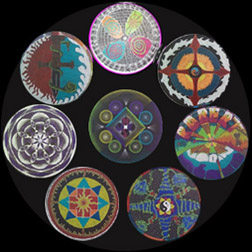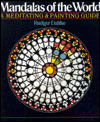
In October of 2000, I started trying to figure out what sort of major course to offer for the two-week "minimester" that is part of my school's academic schedule. During the minimester, students take a "major" class that meets for four hours per day, and a "minor" class that meets for 2 hours per day. Teachers are free to offer courses outside of their regular subject areas, and both students and teachers usually enjoy the change of pace that the minimester provides.
The previous year I'd taught a special sculpture class for my younger students, but this year I wanted to do something different. One night I came up with the idea of doing a class that would be called "Sacred Circles," and when I pitched it to the dean of academics, I said that students would study the different cultures that have used the circle in their religious art, and that they would also create their own circular artwork.
The dean approved the concept of "Sacred Circles" as a major course offering for the minimester, and while I'd like to say that I immediately started planning for it, such was not the case. The schedule at my school is very demanding, and keeping up with my regular schedule of classes--as well as with the other duties that are required of teachers at this school--didn't leave a lot of time to develop the curriculum for this special course.
The minimester was to begin on Monday, November 27th--the day that we returned from the Thanksgiving break--and students registered for their courses before the break began. In other words, I had students signing up for a class that I hadn't even had the chance to plan!
I started developing the outline of the class over the Thanksgiving break, and purchased some books to help me get started. The ones below are books that I found the most helpful--you can click on the covers to learn more about them.



As I started my research, I was really surprised at the near-universal use of the circle in world religions. After my initial concern that I wouldn't have enough material for four hours per day for two weeks, I soon realized that I wouldn't have time to cover all of the information that I was finding. In addition to the books that I used, I also did an incredible amount of research on the internet, printing out close to 300 pages of reference materials from that source, alone!
As I planned the art activities and my lectures, I became especially facinated with Tibetan mandalas, and with the history of Tibet. I knew I would begin the course with an overview of circular artwork throughout the world, and then focus, first, on the study of Tibetan culture and the symbolism of their sacred circles. I'd found a movie that I planned to show to supplement my lecture on the beliefs of the Buddhist religion, and when I previewed it, I was pleased to see that it contained a small segment that showed Tibetan monks creating a sand mandala. The course was finally coming together....
On the Saturday night before we were to start back on Monday, I had a good idea of how each day would be structured, but I was still hoping to include "something more." I'd hoped that I could somehow expose my students to "real" artwork--more than what I could show them in photographs or movies or on webpages--but I knew I'd missed the deadline for putting in a request for a bus for a big field trip to a museum in Washington, D.C.. I wasn't even sure if I could arrange transportation for any type of local field trip, and besides that, I didn't know what we could see, locally, other than circular stained glass windows in some area churches....
There is a small art museum about 15 miles from our school, but I couldn't think of anything in their regular collection that would, in any way, relate to the theme of "Sacred Circles." However, at about 10 p.m. that Saturday night, I visited the museum's website and was absolutely astounded to see that a special art exhibit had opened a week or so earlier, which was called "The Mystical Arts of Tibet"!
I couldn't believe my good fortune, and knew that I'd have to figure out a way to take my students there. Being able to see "real" Tibetan artwork would be the perfect "something more" for the "Sacred Circles" class.
As I excitedly read through the description of "The Mystical Arts of Tibet" exhibit, I was then stunned when I read that Tibetan monks would be creating a sand mandala at the museum during the first week of our course!
I immediately emailed the dean of faculty, and then first thing Monday morning I talked with him and the director of transportation. While the schedule was pretty tight, there was a bus available for use on Wednesday morning of that week, and so our field trip to the museum was set.
Through this marvelous episode of "synchronicity," I was not just able to expose my students to "real" artwork, but they were able to see, first hand, the creation of a Tibetan mandala--one of the world's most beautiful and spiritually significant "sacred circles."

To many students--after two days of study of Tibetan culture, of the country's spiritual and political history since the 1959 invasion by Communist Chinese forces, of the plight of its religious leader and the monks who are forced to live in exile, and of the meaning and symbolism of the mandala in their religion--the field trip proved to be the highlight of the course.
If you would like to see more pictures of the mandala in progress, learn how other cultures and belief systems (including Christianity, Native Americans, and ancient Celts) have used the circle in their religious art, and view some of the artwork that my students produced, please click here.
No images or text may be used
without written permission from
sharon@art-rageous.net